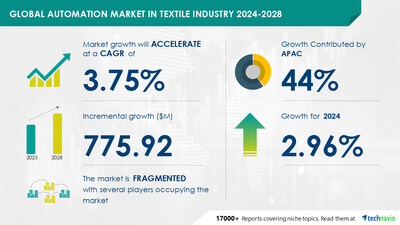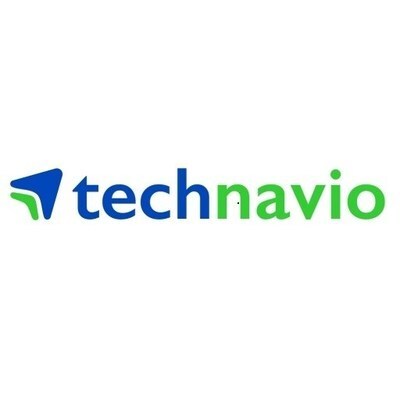
NEW YORK, Nov. 20, 2024 /PRNewswire/ — Report on how AI is driving market transformation – The global automation market in textile industry size is estimated to grow by USD 775.92 million from 2024-2028, according to Technavio. The market is estimated to grow at a CAGR of over 3.75% during the forecast period.Upgrading industrial facilities to improve energy efficiency is driving market growth, with a trend towards use of erp solutions in textile manufacturing plants. However, shortage of skilled workforce poses a challenge.Key market players include ABB Ltd., ATE Pvt. Ltd., Baumuller Nurnberg GmbH, BrainChild Electronic Co. Ltd., CLD Automation, Cotmac Electronics Pvt. Ltd., Delta Electronics Inc., Festo SE and Co. KG, Hitachi Ltd., Honeywell International Inc., KUKA AG, Lenze SE, Niagara Automations, Parker Hannifin Corp., Rockwell Automation Inc., SAURER AG, Schneider Electric SE, SIEGER SPINTECH EQUIPMENTS Pvt. Ltd., Siemens AG, and Yaskawa Electric Corp..
Key insights into market evolution with AI-powered analysis. Explore trends, segmentation, and growth drivers- View Free Sample PDF
|
Automation Market In Textile Industry Scope |
|
|
Report Coverage |
Details |
|
Base year |
2023 |
|
Historic period |
2018 – 2022 |
|
Forecast period |
2024-2028 |
|
Growth momentum & CAGR |
Accelerate at a CAGR of 3.75% |
|
Market growth 2024-2028 |
USD 775.92 million |
|
Market structure |
Fragmented |
|
YoY growth 2022-2023 (%) |
2.96 |
|
Regional analysis |
APAC, Europe, North America, South America, and Middle East and Africa |
|
Performing market contribution |
APAC at 44% |
|
Key countries |
US, China, India, Pakistan, and Germany |
|
Key companies profiled |
ABB Ltd., ATE Pvt. Ltd., Baumuller Nurnberg GmbH, BrainChild Electronic Co. Ltd., CLD Automation, Cotmac Electronics Pvt. Ltd., Delta Electronics Inc., Festo SE and Co. KG, Hitachi Ltd., Honeywell International Inc., KUKA AG, Lenze SE, Niagara Automations, Parker Hannifin Corp., Rockwell Automation Inc., SAURER AG, Schneider Electric SE, SIEGER SPINTECH EQUIPMENTS Pvt. Ltd., Siemens AG, and Yaskawa Electric Corp. |
Market Driver
The textile industry is experiencing significant automation trends that are revolutionizing textile processing, from raw material upgrading at the blow room line to finishing line operations. Automated systems are boosting process efficiency and effectiveness, with innovations like automatic curling, autolevellers, and automated spinning. Sizing, weaving, and dyeing processes are also being transformed with technologies like shuttleless looms, Investa air jets, and aerodynamic systems. Practical automation is key in textile manufacturing, from knitting and dyeing to garment assembly. Robotics, sensors, and artificial intelligence algorithms are driving production efficiency, product quality, and operational flexibility. Faster turnaround times, customization, and sustainability are becoming increasingly important, with technology advancements in digital printing technologies, color accuracy, design flexibility, and environmental sustainability. Textile manufacturers are investing in modern technology to optimize production, reduce energy consumption, and minimize waste. Financial planning and compatibility with existing IT infrastructure are crucial considerations. Workforce displacement, data security, and intellectual property rights are also key concerns. Overall, automation is transforming the textile industry, from traditional production methods to high-quality goods in apparel, home textiles, technical textiles, and industrial textiles.
Enterprise Resource Planning (ERP) software is a valuable tool for textile manufacturers, streamlining business operations across finance, human resources, production, supply chain, services, and purchasing. ERP solutions enhance communication and data exchange between departments, reducing approval times and boosting departmental efficiency. By coordinating business functions, textile plants can minimize miscommunication and improve overall productivity. ERP systems are increasingly popular in the textile industry due to their ability to optimize resources and automate processes.
Request Sample of our comprehensive report now to stay ahead in the AI-driven market evolution!
Market Challenges
- The textile industry is undergoing a significant transformation with the adoption of automation in various processes. Challenges such as raw material upgrading at the blow room line and finishing at the finishing line are being addressed through process boosting and effective carding. Automatic curling, autolevellers, and spinning are being automated for improved production efficiency and product quality. Investment in automated systems for sizing, shuttleless looms, and aerodynamic systems is on the rise. Innovative automation in weaving, multiphase weaving, heat recuperation, and exhaust air purification is optimizing textile manufacturing. Dye houses are adopting practical automation for environmental safe dyeing using AI algorithms and digital printing technologies. Knitting, dyeing, and finishing operations are being streamlined with robotics, sensors, and fabric inspection for faster turnaround times and customization. Technology advancements in textile manufacturing include AI for production optimization, smart textiles, wearable technologies, and electronic components. Sustainability is a key focus with resource utilization, waste minimization, energy consumption, and environmental impact reduction. Investment cost, compatibility, integration, IT infrastructure, workforce displacement, data security, and intellectual property rights are important considerations in automating textile production facilities. Training and upskilling programs are essential for workforce adaptation to modern technology. The automation market is driving the textile industry towards higher productivity, customization, and production of high-quality goods in apparel, home textiles, technical textiles, and industrial textiles.
- Textile manufacturing facilities face a significant challenge in finding enough skilled workers to operate their automated systems. Reports indicate that there were over 63,000 unfilled apprenticeship or training positions in Germany alone in 2021. These facilities require a workforce capable of managing various hardware and software components. However, providing extensive training to existing staff is time-consuming and costly, potentially leading to production downtime. The scarcity of skilled labor in the textile industry necessitates a reevaluation of workforce development strategies to ensure efficient and effective operation of automated systems.
Discover how AI is revolutionizing market trends- Get your access now!
Segment Overview
This automation market in textile industry report extensively covers market segmentation by
- Component
- 1.1 Field devices
- 1.2 Control devices
- 1.3 Communication
- Solution
- 2.1 Hardware and software
- 2.2 Services
- Geography
- 3.1 APAC
- 3.2 Europe
- 3.3 North America
- 3.4 South America
- 3.5 Middle East and Africa
1.1 Field devices- The textile industry’s automation market experienced significant growth in 2022, with the field devices segment leading in revenue generation. Comprising motors, drives, valves, and actuators, these devices are essential for controlling machinery functions and the dyeing process. Their extensive use results in high replacement rates, driving sales. As the textile industry continues to upgrade facilities, demand for automation solutions, particularly field devices, is expected to increase, fueling market expansion. These devices are fundamental to the industry, and their demand is projected to rise throughout the forecast period due to ongoing investments in the industrial sector.
Download a Sample of our comprehensive report today to discover how AI-driven innovations are reshaping competitive dynamics
Research Analysis
The automation market in the textile industry is witnessing significant growth due to the increasing demand for high-quality, efficient, and sustainable textile production. Automation in textile processing includes various stages such as blow room line, finishing line, ginning, carding, drawing, and spinning. Automation in raw material upgrading through processes like autolevellers and sensors enhances resolution and reduces wastage. Robotics and automation in knitting, dyeing, and garment assembly increase factory production and improve product consistency. Process boosting technologies like automatic curling and resolution control optimize energy usage and improve product quality. Overall, automation in textile processing leads to the production of high-quality goods while reducing production costs and enhancing sustainability.
Market Research Overview
The automation market in the textile industry is experiencing significant growth due to the integration of advanced technologies such as Blow room lines, Finishing lines, and automated systems in various textile processing stages. These automated solutions are revolutionizing textile manufacturing by boosting process efficiency, effective raw material upgrading, and optimizing production. Automation is transforming textile processing through innovative technologies like automatic curling, Autolevellers, and shuttless looms. Investa air jet technology and traveling future are leading the way in heat recuperation and exhaust air purification, ensuring environmental safety. Textile finishing operations are being automated with practical solutions, including sizing, dye houses, and optimization of color accuracy and design flexibility. Digital printing technologies and AI algorithms are enhancing production efficiency, product quality, and operational flexibility. The textile industry is embracing automation for apparel, home textiles, technical textiles, and industrial textiles, resulting in faster turnaround times, customization, and resource utilization. Technology advancements, such as smart textiles and wearable technologies, are integrating electronic components and sensors for enhanced functionality. Investment in automation requires careful financial planning, compatibility with existing IT infrastructure, and consideration of workforce displacement, data security, and intellectual property rights. The future of textile manufacturing lies in modern technology, resolution, and factory production, with a focus on sustainability, waste minimization, energy consumption, and environmental impact.
Table of Contents:
1 Executive Summary
2 Market Landscape
3 Market Sizing
4 Historic Market Size
5 Five Forces Analysis
6 Market Segmentation
- Component
- Field Devices
- Control Devices
- Communication
- Solution
- Hardware And Software
- Services
- Geography
- APAC
- Europe
- North America
- South America
- Middle East And Africa
7 Customer Landscape
8 Geographic Landscape
9 Drivers, Challenges, and Trends
10 Company Landscape
11 Company Analysis
12 Appendix
About Technavio
Technavio is a leading global technology research and advisory company. Their research and analysis focuses on emerging market trends and provides actionable insights to help businesses identify market opportunities and develop effective strategies to optimize their market positions.
With over 500 specialized analysts, Technavio’s report library consists of more than 17,000 reports and counting, covering 800 technologies, spanning across 50 countries. Their client base consists of enterprises of all sizes, including more than 100 Fortune 500 companies. This growing client base relies on Technavio’s comprehensive coverage, extensive research, and actionable market insights to identify opportunities in existing and potential markets and assess their competitive positions within changing market scenarios.
Contacts
Technavio Research
Jesse Maida
Media & Marketing Executive
US: +1 844 364 1100
UK: +44 203 893 3200
Email: [email protected]
Website: www.technavio.com/
View original content to download multimedia:https://www.prnewswire.com/news-releases/automation-market-in-textile-industry-to-grow-by-usd-775-92-million-2024-2028-as-ai-powers-market-evolution-facility-upgrades-boost-energy-efficiency—technavio-302311075.html
SOURCE Technavio



